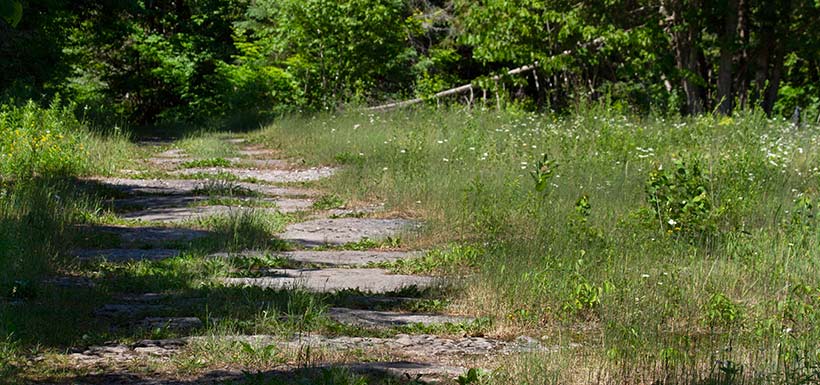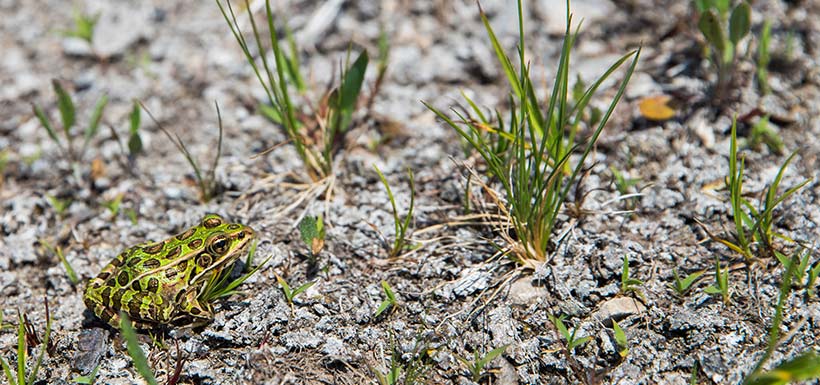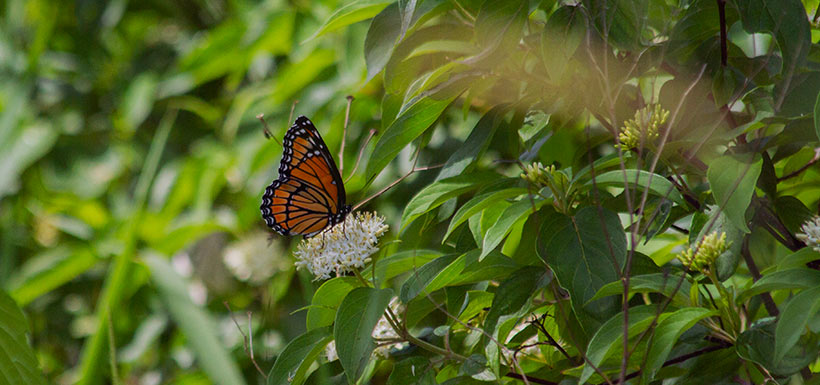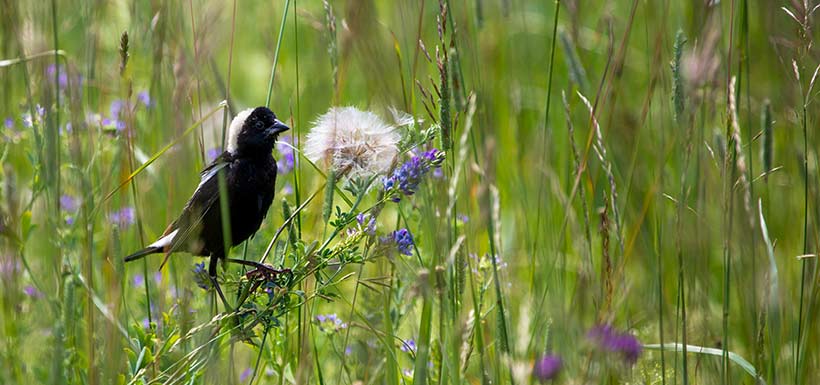Episode Four: The Home of the Butcher Bird
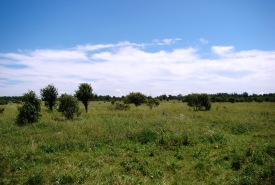
Carden Alvar, ON (Photo by NCC)
This is the story of a globally rare ecosystem discovered by chance — and why it matters.
Take the quiz here
NCC on location: Carden Alvar Natural Area
Castbox | Podbean | Player FM | Stitcher | TuneIn
Transcript: The Home of the Butcher Bird
TIFFANY CASSIDY (HOST): This is the story of a place where only the toughest survive.
(SOUND OF A LOGGERHEAD SHRIKE SQUWAKING)
(SFX SUSPENSFUL MUSIC)
KRISTYN FERGUSON: Sometimes you close your eyes at night and you’re like, “Get out of my nightmares!”
TIFFANY CASSIDY: You’re listening to Nature Talks: the Nature Conservancy of Canada Podcast. Fascinating stories about nature, why we need it in our lives, and the passionate Canadians helping to protect it. I’m Tiffany Cassidy. This is episode 4 — The Home of the Butcher Bird.
(SUSPENSFUL MUSIC)
(DRIVING CAR SOUNDS)
TIFFANY CASSIDY: Bob Bowles still remembers the day he first saw it…
BOB BOWLES: I thought, “What’s the quickest way to go from point A to point B?” And I drew a line on the map. And I took this country road that wasn’t often travelled, and suddenly I came on an area that I’ve never been to before that looked completely different. The plants were different, the trees were different.
TIFFANY CASSIDY: He was on his way to a meeting…He didn’t linger…
BOB BOWLES: The landscape looks flat and like pavement, so we moved on, but that was always in the back of my mind — that special area in this back road.
(BIRD SOUNDS)
TIFFANY CASSIDY: Since that day in 1975, the special place has lured him back many times. An avid naturalist, Bob spent years learning and sharing the secrets of this unusual landscape. Back then he didn’t even have a name for it. Today, we know it as the Carden Alvar, just east of Orillia, Ontario.
(BIRD SOUNDS)
TIFFANY CASSIDY: Alvars are exceedingly rare ecosystems. They are sometimes called limestone barrens. They’re bare rock, sometimes covered with just a thin layer of soil — wide open expanses of grasses and wildflowers. You’ll only find them in a handful of places around the planet. But most of the world’s alvars are here in Ontario, south of the Canadian Shield. These are places where only the hardiest survive.
BOB BOWLES: Very harsh environments. It gets completely baked dry in the summer, but in the spring it floods when the snow melts and the meltwaters have no place to go so it floods. So if you’re going to live in this area, you gotta be a hardy plant. You’ve gotta go through spring floods and summer droughts. And these plants were growing up and they were yellow, they were blue, they were bold colours. It was just such an experience — a complete new world.
TIFFANY CASSIDY: A world with a completely unique collection of species. The hardscrabble barrens are perfect for lichens and fungi. But there’s also about 400 different plants, like wispy prairie smoke and vivid orange painted cup and many other wildflowers. The plants attract hundreds of insect species, including many dragonflies and butterflies.
Behind the scenes
(FLY SOUND)
And the insects attract the birds….
BOB BOWLES: The whole ecosystem is so important. The grasshoppers I hear at night, the katydids, the whip-poor-wils are out there. It’s just a mixture of so many species that are working in an ecosystem, harmonizing with each other, and without an alvar we wouldn’t have that. We need to protect those special areas.
TIFFANY CASSIDY: Several conservation organizations are working to protect the Carden Alvar. Kristyn Ferguson manages the project for the Nature Conservancy of Canada. Since 1998, the group has helped to protect more than 9,000 acres here. She’s leading restoration efforts that include removing the invasive plants that can outcompete native alvar plants. These invasive plants can grow over the open spaces in the alvar, and the unique birds here need that open space to hunt. Kristyn’s biggest challenge is a particularly gruesome-sounding invader.
(SUSPENSEFUL MUSIC)
KRISTYN FERGUSON: Dog-strangling vine as one of the biggest threats. The rest of the world knows it as pale swallowwort, but it’s not been known to strangle any dogs, as far as I know. But it is this nasty vine. You could see if a dog went running into a patch of it you might get it stopped pretty quickly because the vine is on the ground and tangles up. So it’s this soft-stemmed green vine that grows with these little maroon flowers, and it likes, you know what, it just likes too many habitats. It likes forests, it likes ravines, open places and it loves alvars, which is really unfortunate because it’s so incredibly aggressive. No native predators and nobody really likes to eat it, even our deer or cattle, so off it goes and it can really take over these habitats in no time.
TIFFANY CASSIDY: It even invades her dreams.
KRISTYN FERGUSON: After a long day in the field of controlling dog-strangling vine, all I want to do is forget about it, but sometimes you close your eyes at night and you can just see the seed pods, see the leaves on the screens of your eyelids, and you’re like “Get out of my nightmares!” But it keeps me on my toes. I think my active hatred for it really propels the invasive species program forward.
TIFFANY CASSIDY: The alvar holds one more macabre surprise. It’s also home to a pretty little songbird — with the heart of a hawk, and a killer reputation. The butcher bird...after the break.
(THEME MUSIC)
TIFFANY CASSIDY: The Nature Conservancy of Canada is a national charity. We protect important natural areas for the species that need them — species from the wispy prairie smoke to humans. Learn more about alvars and our work by going to our website. There’s an alvar quiz waiting for you. The website is natureconservancy.ca/podcast. That's nature c-o-n-s-e-r-v-a-n-c-y.ca.
TIFFANY CASSIDY: When Bob Bowles stumbled across the Carden Alvar more than 40 years ago, he knew it was special.
BOB BOWLES: The birds I saw. I stopped quickly and I saw a loggerhead shrike on the side of the road and I thought, “That’s a loggerhead shrike, but I’ve never seen them in this area before.”
TIFFANY CASSIDY: The eastern loggerhead shrike is pretty unusual. It’s a songbird, about the size of a robin, that sounds like this.
(LOGGERHEAD SHRIKE CALL)
TIFFANY CASSIDY: But it’s a predatory songbird. Insects, frogs, mice, even other birds are all on the menu. Shrikes don’t have the talons of a raptor. So instead shrikes fly close, pick up their prey in their beak and drive it into something pointy, like thorns, sharp twigs or barbed wire. And the shrike impales its meal, hanging its meal the way a butcher hangs its meat. Hence the name…the butcher bird. Wide open alvars are great habitat for this endangered bird. And the Carden Alvar is perfect for a shrike recovery program.
(SHRIKES SWAWKING, CARDBOARD BOX RATTLING)
That rattling and squawking you hear are juvenile shrikes. They’ve just been transferred here from captive breeding facilities. A team is here to release them into the wild.
HAZEL WHEELER: So we have all these shrikes in boxes and we need to carry them along with all of their food and water.
TIFFANY CASSIDY: That’s Hazel Wheeler. She works for Wildlife Preservation Canada. And she’s the lead biologist with the shrike recovery program. Since 2005, shrikes have been released at the Carden Alvar in efforts to help the population recover.
HAZEL WHEELER: Right now, I mean it’s just a matter of figuring out how to carry as many birds down with as little trouble as possible. Because the cage that we’re going to is going to be about a kilometre across a rather rough field.
(SOUNDS OF WALKING ON GROUND)
TIFFANY CASSIDY: We walk towards the outdoor shrike cages. Large wooden structures about three metres high and two metres across, each wrapped with wire screens. Inside there are branches, and even some barbed wire so the young shrikes can practice impaling their prey.
(SOUNDS OF SETTING UP CAGES)
TIFFANY CASSIDY: Hazel’s team sets up the cages with everything the shrikes will need. They put mealworms and crickets in their feeding tray.
(CRICKET SOUNDS)
TIFFANY CASSIDY: With some dead mice and some water. It’s ready for the shrikes. One at a time, the boxes are opened inside the cages…
(SOUND OF BIRD FLYING)
TIFFANY CASSIDY: And the young shrikes fly out.
(SOUND OF FLAPPING IN CAGE)
(SHRIKE SKWAWK)
TIFFANY CASSIDY: The shrikes flap around in the cages. They’ll spend a week in here getting used to their surroundings. And they’ll practice the hunting skills their parents taught them in captivity. The team will put live mice in the cages for practice.
HAZEL WHEELER: The younger juveniles at the release sites, sometimes it takes them a little while to get the hang of it. But they get there eventually. Sometimes you also see them practicing their impaling skills with a leaf or something else they might find in the enclosure. That’s really quite charming.
(SOUND OF SHRIKES FLAPPING)
TIFFANY CASSIDY: The release program, now 17 years old, appears to be having an impact.
HAZEL WHEELER: Every year we do see some of our release birds coming back. So for example last year almost half of the fledglings that we saw in the wild came from pairs where at least one of the adults was a captive origin bird. So they’re definitely making an impact.
TIFFANY CASSIDY: This species needs all the help it can get. The eastern population of loggerhead shrikes is down to fewer than 100 mature birds.
HAZEL WHEELER: We’ve seen promising numbers and so you know I just kind of cross my fingers and hope for the best each year.
TIFFANY CASSIDY: On the final release day, Hazel and her team will open the cage doors, and put food outside, to coax the birds to leave.
(OPENING CAGE DOORS)
TIFFANY CASSIDY: Then Hazel and everyone will hide back in the field watching, waiting for the shrikes to fly out across the Carden Alvar.
HAZEL WHEELER: And that moment where, you know, the birds leave the cage, it’s…you know these little feathered babies that we’ve seen grow up, it’s really… it’s emotional. It’s hopeful. And it’s just a really lovely way to spend the day.
(THEME MUSIC)
TIFFANY CASSIDY: The Nature Conservancy of Canada does amazing things — like protecting alvars, a globally rare ecosystem. This work is only possible because generous people like you donate. If you would like to support this work go to natureconservancy.ca/podcast and click on the big orange donate button. All amounts make a difference.
TIFFANY CASSIDY: Like what you heard on our podcast? Subscribe to future episodes on your favourite app. Give us a tweet [BIRD SOUNDS] using the hashtag Nature Talks Podcast. Share it with a friend. Or email us at podcast@natureconservancy.ca. Are you looking to explore the amazing places we talk about in this podcast? Go to natureconservancy.ca/podcast to see our sites that you can visit. Next time we’re exploring the most endangered ecosystem in the world…and the research that’s trying to help save it. Thanks to Bob Bowles and Hazel Wheeler for sharing their stories and knowledge with us. Thanks to Kristyn Ferguson for her expertise, and to everyone at the Nature Conservancy of Canada who put this together. And thanks to Pop Up Podcasting. Some of the birds you heard were from the Macaulay Library at the Cornell Lab of Ornithology, from recordists Wil Hershberger and Geoffrey A. Keller. This banjo theme music you're listening to is by NCC staffer/musician Carly Dow. I’m Tiffany Cassidy. Thanks for listening.
Thanks to our partners
Thank you to our generous for their support of the Carden Alvar, including:
- Government of Canada, under the Natural Areas Conservation Program
- TD Friends of the Environment Foundation
- John Speakman
- Ontario Trillium Foundation




